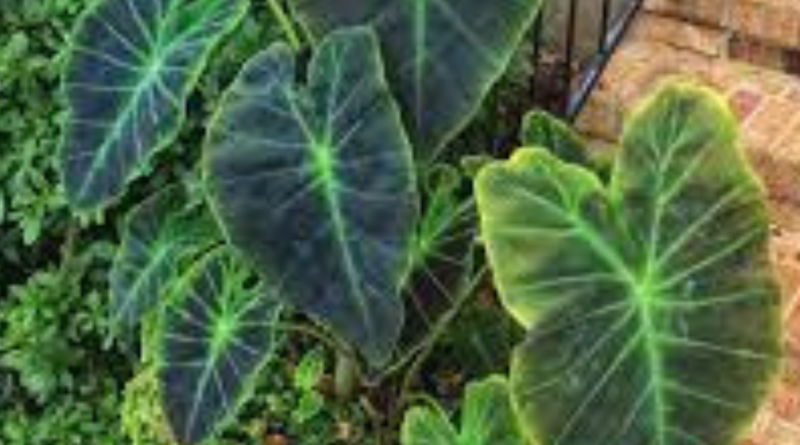Elephant Ear Plant
The elephant ear plant (Colocasia esculenta) is a tropical plant native to Southeast Asia and widely cultivated for its large, heart-shaped leaves. The leaves, which can grow up to 3 feet long and 2 feet wide, resemble the ears of an elephant, hence the name.
The elephant ear plant prefers warm, moist environments and grows best in well-drained soil with regular watering. It can be grown both indoors and outdoors, depending on the climate. It is often used as an ornamental plant in landscaping, as it adds a tropical feel to gardens and landscapes.
In addition to its ornamental value, the elephant ear plant is also used in cuisine in many cultures. The corms (underground stems) of the plant are a common ingredient in traditional dishes in Southeast Asia, Africa, and the Caribbean. They are starchy and have a nutty flavor, and can be boiled, baked, or fried.
Elephant ear plant type
There are several types of elephant ear plants, including:
- Colocasia esculenta: This is the most common type of elephant ear plant, with large, heart-shaped leaves that can grow up to 3 feet long and 2 feet wide. It is native to Southeast Asia and is widely cultivated for its ornamental and culinary value.
- Alocasia macrorrhiza: Also known as the giant taro, this elephant ear plant has large, arrow-shaped leaves that can grow up to 4 feet long and 3 feet wide. It is native to tropical Asia and is often grown as an ornamental plant.
- Xanthosoma sagittifolium: This elephant ear plant is also known as the arrowleaf elephant ear or the tannia. It has arrow-shaped leaves that can grow up to 3 feet long and 2 feet wide, and is native to tropical America.
- Caladium bicolor: This elephant ear plant is also known as the angel wings or heart of Jesus plant. It has heart-shaped leaves that come in a variety of colors, including green, pink, and red. It is native to South America and is often grown as an ornamental plant.
- Philodendron bipinnatifidum: This elephant ear plant is also known as the tree philodendron or split-leaf philodendron. It has large, deeply lobed leaves that can grow up to 3 feet long and 2 feet wide. It is native to South America and is often grown as an indoor plant.
Black elephant ear plant
The black elephant ear plant is a tropical plant that prefers warm, humid environments and well-draining soil. It is often grown as an ornamental plant in landscaping, as it adds a striking visual element to gardens and landscapes. It can also be grown in containers indoors or on patios, provided it receives enough light and water.
Like the regular elephant ear plant, the black elephant ear plant can be used in cuisine in some cultures. The corms of the plant are starchy and edible, and are often used in traditional dishes in Southeast Asia, Africa, and the Caribbean. However, it is important to note that the plant is toxic if ingested raw and should be cooked thoroughly before consumption.
Pink elephant ear plant
The pink elephant ear plant is a tropical plant that prefers warm, humid environments and well-draining soil. It is often grown as an ornamental plant in landscaping, as it adds a unique and colorful element to gardens and landscapes. It can also be grown in containers indoors or on patios, provided it receives enough light and water.
Like the regular elephant ear plant, the pink elephant ear plant can be used in cuisine in some cultures. The corms of the plant are starchy and edible, and are often used in traditional dishes in Southeast Asia, Africa, and the Caribbean. However, it is important to note that the plant is toxic if ingested raw and should be cooked thoroughly before consumption.
Purple elephant ear plan
The purple elephant ear plant is a cultivar of the elephant ear plant (Colocasia esculenta) with dark purple leaves. The leaves of this plant are large and heart-shaped, like those of the regular elephant ear plant, but have a deep, rich shade of purple.
The purple elephant ear plant is a tropical plant that prefers warm, humid environments and well-draining soil. It is often grown as an ornamental plant in landscaping, as it adds a unique and striking visual element to gardens and landscapes. It can also be grown in containers indoors or on patios, provided it receives enough light and water.
Like the regular elephant ear plant, the purple elephant ear plant can be used in cuisine in some cultures. The corms of the plant are starchy and edible, and are often used in traditional dishes in Southeast Asia, Africa, and the Caribbean. However, it is important to note that the plant is toxic if ingested raw and should be cooked thoroughly before consumption.
Elephant ear plant indoors
Here are some tips for growing elephant ear plants indoors:
- Light: Elephant ear plants need bright, indirect light to thrive indoors. They should be placed near a window that receives plenty of natural light, but not direct sunlight.
- Temperature: Elephant ear plants prefer warm temperatures between 65 and 80°F (18-27°C). They should be kept away from drafts and cold windows.
- Humidity: Elephant ear plants prefer humid environments, so it is important to keep them in a room with high humidity or use a humidifier to increase moisture levels.
- Watering: Elephant ear plants need to be watered regularly, but not overwatered. Allow the soil to dry out slightly between watering’s, but don’t let it completely dry out.
- Soil: Elephant ear plants need well-draining soil that is rich in organic matter. A mixture of peat moss, perlite, and sand is a good choice.
- Fertilizer: Elephant ear plants benefit from regular fertilization with a balanced, water-soluble fertilizer. Apply fertilizer once a month during the growing season (spring and summer).
- Pruning: Elephant ear plants can become quite large, so it may be necessary to prune them back occasionally to keep them from taking over your space.
Overall, with the right care and growing conditions, elephant ear plants can be a beautiful and unique addition to your indoor plant collection.
How to plant elephant ear bulbs
Here are the steps to plant elephant ear bulbs:
- Choose a location: Elephant ear plants prefer well-draining soil and partial shade. Choose a location that is protected from strong winds and receives at least four hours of sunlight per day.
- Prepare the soil: Prepare the soil by digging a hole that is twice as wide as the bulb and deep enough to accommodate the bulb and some soil around it. Mix compost or other organic matter into the soil to improve drainage and fertility.
- Plant the bulb: Place the bulb in the hole with the pointy end facing up. Cover the bulb with soil, leaving the top third of the bulb exposed.
- Water the bulb: Water the bulb thoroughly after planting to settle the soil around the bulb and provide moisture.
- Mulch the area: Mulch the area around the bulb with a layer of organic material, such as straw or leaves. This will help retain moisture in the soil and regulate soil temperature.
- Water and fertilize: Water the bulb regularly, keeping the soil consistently moist but not waterlogged. Fertilize the bulb with a balanced, water-soluble fertilizer every two to four weeks during the growing season (spring and summer).
- Provide support: As the elephant ear plant grows, it may require support to prevent it from falling over. Use a stake or trellis to support the plant as needed.
By following these steps, you can successfully plant elephant ear bulbs and enjoy the beautiful foliage of this tropical plant.
Is elephant ear plant poisonous
It is important to keep elephant ear plants out of reach of children and pets, and to wear gloves when handling the plant to avoid skin irritation. If you suspect someone has ingested part of an elephant ear plant, seek medical attention immediately.




